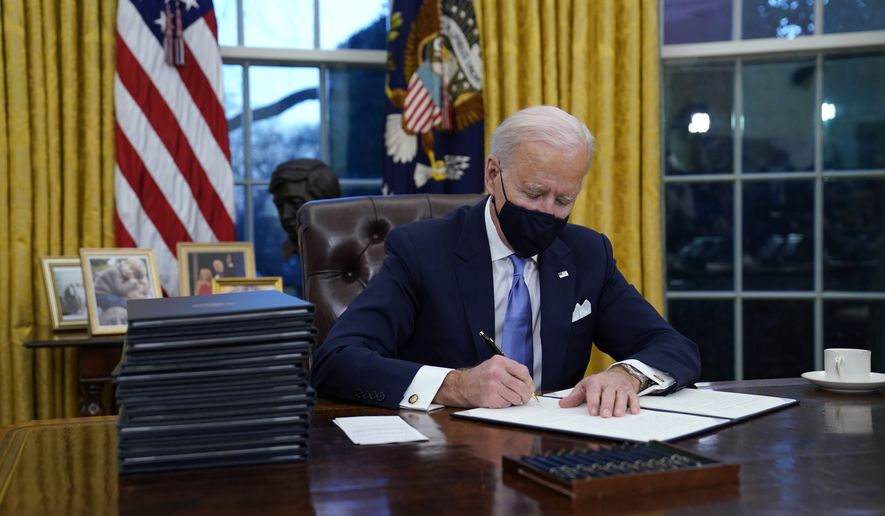The Supreme Court signaled trouble for the administration’s catch-and-release border policies on Tuesday, with justices questioning the legal basis Homeland Security is using to parole thousands of illegal immigrants into the U.S. each day.
The justices repeatedly clashed with President Biden’s lawyer over the massive number of releases happening right now and the administration’s failure to take concrete action to deter or detain more of the new arrivals.
“You’re sort of making it even harder to do anything other than release people encountered at the border into the United States,” Chief Justice John G. Roberts Jr. told Solicitor General Elizabeth Prelogar.
Ms. Prelogar was in court to defend the administration’s attempt to shut down the Trump administration’s “Remain in Mexico” policy that sent illegal immigrants at the southern border back into Mexico to wait for the outcome of their immigration proceedings.
Texas sued, arguing that the unilateral cancelation of the policy, formally known as Migrant Protection Protocols or MPP, violated administrative law. Lower courts agreed with Texas and ordered Homeland Security to restart the program.
The justices on Tuesday cast the case as a broader test of the administration’s border policies at a time when illegal immigration is already setting records and Homeland Security is warning the number of border jumpers could triple.
Ms. Prelogar suggested the administration has limited options. It can detain or release them on bond, though capacity there is limited. It can also return them across the border, or it can “parole” them into the country.
It’s that latter power that Homeland Security Secretary Alejandro Mayorkas has been flexing, releasing tens of thousands of migrants each month under his parole authority.
The law says that parole must be done on a case-by-case basis, and only when there is a “significant public benefit.”
Ms. Prelogar said the public benefit in this case is releasing some border crossers so more serious people can be detained in the limited bed space available for migrant detention.
She said Mr. Mayorkas did a cost-benefit analysis and concluded releasing illegal immigrants in the U.S. was a better option than trying to return them to Mexico.
Justice Stephen G. Breyer wondered why more people can’t be detained.
“Did you ask for more? Did you ask Congress for more?” he said.
Ms. Prelogar said Congress makes those decisions about detention space at U.S. Immigration and Customs Enforcement.
The administration has not proposed any increases in beds but instead pushed for cuts to ICE’s detention capacity. Ms. Prelogar said the president has, however, asked for more money for alternatives to detention and for more immigration judges to speed up cases.
“We are seriously engaging with whatever challenges exist at the border,” she said.
Even as they questioned the scope of catch-and-release, justices wondered whether there was much they could do about it. The Remain in Mexico policy relies on a section of the law that gives the administration discretion, rather than making it mandatory.
For one thing, Justice Elena Kagan said, Mexico has some say in whether the U.S. can push people back over the line.
“You’re putting the secretary’s immigration decisions in the hands of Mexico,” she told Texas Solicitor General Judd Stone, who argued the case for the administration’s opponents.
Chief Justice Roberts said that even if the MPP policy is fully restored, it’s not going to do very much to solve the border chaos, given the numbers crossing and the numbers that can be returned.
“It’s not going to make a difference,” he said.
Mr. Stone said any mitigation would help. Besides, he said, the administration is still violating the law.
“Fewer statutory violations … is better than more,” he said.
The Trump administration created the Remain in Mexico program in 2019 amid a previous border surge. The program started slowly, requiring cooperation from a reluctant Mexico.
After then-President Donald Trump threatened crippling economic sanctions in June 2019, Mexico rushed to cooperate. The program began to enroll thousands of returnees each month, and border numbers quickly dropped to more manageable levels.
Immigrant-rights advocates said those being sent back to Mexico faced hardships ranging from lack of support to kidnappings and abuse at the hands of criminal gangs and cartels.
The Biden administration agreed and began a phaseout of the program soon after it took control.
After a judge ruled the phaseout illegal and ordered a restart, the Biden team has been sluggish to get things moving.
In March, just 199 migrants were subjected to MPP.
By contrast, in March 2020, just before the pandemic hit, 2,255 migrants were enrolled in MPP by the Trump administration.
Once the pandemic struck, the government triggered Title 42, a health policy that allowed illegal immigrants to be expelled to Mexico even more expeditiously than MPP.
The Biden administration now wants to end Title 42 next month.
Border experts say without Title 42 or MPP, migrants will surge into the U.S., looking to take advantage of the broken immigration system. Homeland Security has projected an onslaught of as many as 18,000 illegal immigrants a day, or nearly three times the current record-setting levels.
A federal judge in Louisiana issued a ruling Monday imposing a temporary restraining order on the administration’s Title 42 phaseout.
That decision is the latest in a string of court losses for Mr. Biden on immigration.
Judges — many of them appointed by Mr. Trump — have ruled that the Biden team is cutting too many corners in its executive actions, in violation of the Administrative Procedure Act. That law requires executive branch decisions to be well-reasoned and requires giving the public a chance to submit comments before major changes take place.
• Stephen Dinan can be reached at sdinan@washingtontimes.com.




Please read our comment policy before commenting.